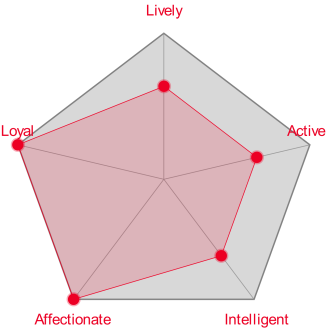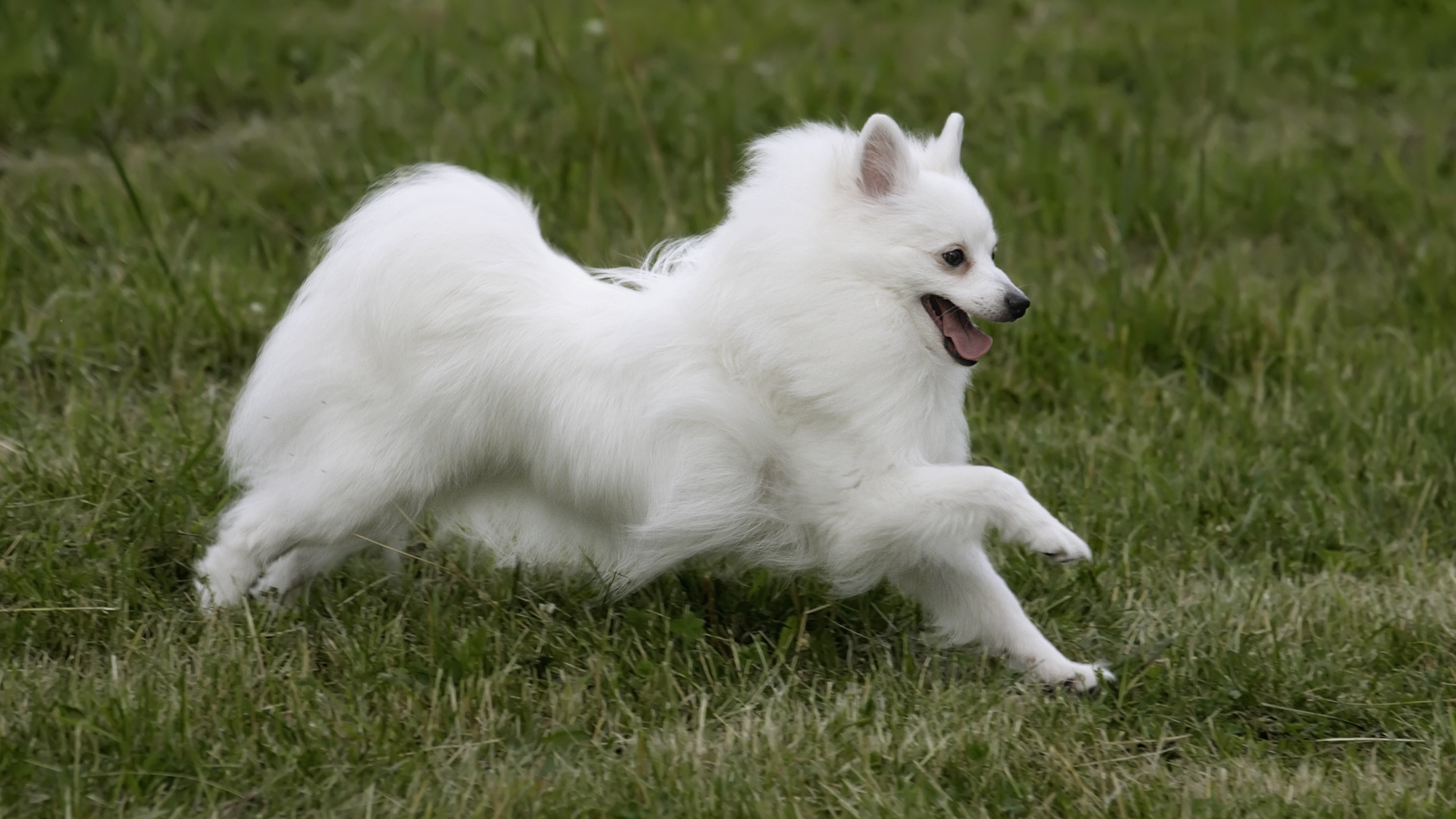
Let's talk Italian Volpino Dogs
The gorgeous Italian Volpino, often confused with the Pomeranian, is rarely spotted outside of their native country. Their resplendent fluffy coat is usually white, which helps those dark eyes to really pop. Their petite size means that Italian Volpino dogs are suited to an apartment, but ideally they would have some access to a secure space outside. In terms of temperament, the Italian Volpino is a cheerful canine and affectionate towards their family. They’re also not averse to climbing onto your lap for a cuddle.
Official name: Italian Volpino
Other names: VOLPINO ITALIANO, LUPINO
Origins: Italy

| Drooling tendencies |  |
Warm weather? |  |
| Shedding level |  |
Suited to apartment living? |  |
| *Energy Level | Low | *Friendly pet? |  |
| Compatibility with other pets |  |
*Can stay alone? |  |
* We advise against leaving pets alone for long stretches. Companionship can prevent emotional distress and destructive behavior. Speak to your veterinarian for recommendations.
Every pet is different, even within a breed; this snapshot of this breed specifics should be taken as an indication.
For a happy healthy and well-behaved pet, we recommend educating and socializing your pet as well as covering their basic welfare needs (and their social and behavioral needs).
Pets should never be left unsupervised with a child.
Contact your breeder or veterinarian for further advice.


| Baby age | Birth to 2 months |
| Puppy age | 2 to 10 months |
| Adult age | 10 months to 8 years |
| Mature age | 8 to 12 years |
| Senior age | From 12 years |
1/7
Get to know the Italian Volpino
All you need to know about the breed
The Italian equivalent of a Spitz (not a Spritz), Italian Volpino dogs are beloved in their homeland by literally everyone. They’re incredibly alert, which earned the respect of farmers who used them as watchdogs. But they’re also fluffy and adorable, which made them popular lap dogs for wealthy Italians. And the lively Italian Volpino enjoys the company of humans, showing great affection towards them.
Their working dog heritage means that the Italian Volpino is energetic for a canine of such small stature. They will appreciate tasks that use their scent skills and hone their agility. They’ll also thrive with access to outdoor space: a garden would be ideal for them to run around in and enjoy a spot of sunbathing. Apartments can be ok, so long as they’re getting enough daily exercise.
With early training and socialisation, the Italian Volpino cohabits peacefully with both cats and children. They tend to prefer older children who are less high-spirited but like any other breed, children and dogs should never be left unsupervised. Thanks to their sunny temperament, the Italian Volpino is suited to active families, active singles and active retirees. Emphasis on the “active”.
2/7
2 facts about Italian Volpino dogs
1. Let’s get loud
The Italian Volpino is usually on high alert, which makes them great watchdogs. But they also use it to express their displeasure at something or if they’re bored. They will benefit from early training to temper this vocal tendency.
2. Artist’s muse
With a history of rubbing shoulders with the wealthy, or rather sitting in their laps, the Italian Volpino has come to the attention of some influential creatives. For instance, the artist Michalangelo, who painted them into his work in the 1400-1500s. What a claim to fame.
History of the breed
The Italian Volpino can be tied to the ancient Spitz, so they’ve basically been around in some form since forever. The record-keeping was sparse, but clues from art and the physical resemblance to the Spitz suggest that the breed dates back to the 15th century in Italy.
The Italian Volpino was formerly used as a watchdog on farms, where their high-pitched barks signalled suspicious behaviour to larger guard dogs, who would investigate further. The breed faced extinction in the 1960s, although the reason for this is unclear. The Italian Kennel Club sprung into action by establishing an intensive breeding programme, which helped to save the breed. Despite this success, the Italian Volpino remains a very rare breed, almost never seen outside of their homeland.
They were only recognised by the United Kennel Club in 2006, followed by the Fédération Cynologique Internationale in 2015. They have yet to receive recognition from the American Kennel Club due to their sparse presence stateside. If you would like to welcome an Italian Volpino into your life, you may have to move to Italy, or at least join a waitlist.

4/7
From head to tail
Physical characteristics of Italian Volpino dogs
1. Body
Body is square shaped, covered in dense, long hair.
2. Ears
Triangular shaped ears, that sit high and close together.
3. Tail
A high-set tail that curls over the back and narrows at the tip.

5/7
Things to look out for
From specific breed traits to a general health overview, here are some interesting facts about your Italian Volpino

6/7
Caring for your Italian Volpino
Grooming, training and exercise tips
All that fluff may feel overwhelming, but the Italian Volpino requires two weekly brushings. During seasonal shedding, this should be increased to daily. Their ears and eyes should be cleaned weekly to help prevent infections from developing. Your Italian Volpino’s nails should be clipped regularly and teeth should also be brushed frequently, daily if possible. As a small breed, they are prone to periodontal disease. The Italian Volpino is a small dog but also energetic, alert and curious. They will require one long walk per day, as well as interactive games and challenges in a securely enclosed space to keep them mentally stimulated. A bored Italian Volpino is likely to be destructive and bark a lot. This is a smart breed that is eager to learn new tricks at any age. They are also motivated by anything food related, which can be handy during training sessions with your Italian Volpino. But remember, any food rewards should come out of their daily kibble rations to avoid weight gain.
7/7
All about Italian Volpino dogs
This loyal dog is capable of forming strong bonds with their humans. The Italian Volpino also has a playful temperament and enjoys receiving attention from their family, whether that’s being active or curling up in your lap for a cuddle. With training, they get on well with older children and even cats if introduced early on.
No, the Italian Volpino does not shed excessively, which is a pleasant surprise given all that beautiful fur. Like many other dogs, they shed seasonally, so do require a bit more grooming during this time. This will keep your furniture free of fluff.
translations.feature.breeds.otherbreeds
Read more on this topic

How your dog's nutrition needs change with age

How to adopt a dog

Things to consider before getting a dog
Sources
1 - Veterinary Centers of America https://vcahospitals.com/
2 - Royal Canin Dog Encyclopaedia. Ed 2010 and 2020
3 - Banfield Pet Hospital https://www.banfield.com/
4 - Royal Canin BHN Product Book
5 - American Kennel Club https://www.akc.org/


